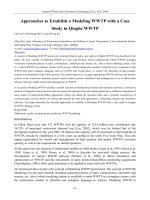Establish a Surveillance System
Bạn đang xem bản rút gọn của tài liệu. Xem và tải ngay bản đầy đủ của tài liệu tại đây (1.13 MB, 22 trang )
<span class="text_page_counter">Trang 2</span><div class="page_container" data-page="2">
<i>First question: Why do you want to </i>
<i>conduct surveillance? </i>
<small>•</small> Detect emerging pathogen, reappearance of an old one, or outbreaks.
<small>•</small> Monitor behavior of existing pathogens
<small>•</small> Monitor trends in epidemiology: risk factors, age groups, seasonality, etc.
<small>•</small> Measure disease burden: absolute (incidence) or relative to other diseases
<small>•</small> Evaluate impact of an intervention
<small>•</small> It’s helpful to actually write down the objectives
<small>19-23 June 2017 FETP Vietnam | Cohorts 7 & 8 Surveillance Module 2 </small>
</div><span class="text_page_counter">Trang 3</span><div class="page_container" data-page="3">The answers will determine:
<small>•</small>
Will the system be active or passive?
<small>•</small>
Will it be a sentinel indicator-based system or an event detection system
<small>•</small>
What diseases will you measure?
<small> Will it be more than one? based on syndromic Surveillance and/or laboratory testing? </small>
<small>•</small>
Will this be a new system or will you add on to existing system?
<small>•</small>
What population will you monitor?
</div><span class="text_page_counter">Trang 4</span><div class="page_container" data-page="4">Decisions to Make
<small>•</small>
What data will you collect?
Decide first, what the major public health questions are.
With a limited sentinel system, can also get risk factor data such as age, medical conditions, vaccination status, etc.
<small>•</small>
Who will collect, analyze and report data?
<small>•</small>
Who will interpret data and take action?
<small>•</small>
How will report be shared and to whom?
<small>•</small>
How will system be monitored?
<small>19-23 June 2017 FETP Vietnam | Cohorts 7 & 8 Surveillance Module 4 </small>
</div><span class="text_page_counter">Trang 5</span><div class="page_container" data-page="5">Support Needed
<small>•</small>
Administrative
Laws <small>•</small>
Political
Ministry of Health
Medical community <small>•</small>
Resources
Funding
Staff
Training
</div><span class="text_page_counter">Trang 6</span><div class="page_container" data-page="6"><small>19-23 June 2017 FETP Vietnam | Cohorts 7 & 8 Surveillance Module 6 </small>
<b>SETTING UP THE SYSTEM </b>
</div><span class="text_page_counter">Trang 7</span><div class="page_container" data-page="7">What are the necessary bits?
<small>•Data: </small>
<small> Source content </small>
</div><span class="text_page_counter">Trang 8</span><div class="page_container" data-page="8">Steps to establishing a new system
</div><span class="text_page_counter">Trang 9</span><div class="page_container" data-page="9">Data sources
<small>•</small>
Identify what data to collect
Decide how it will be used, what decisions will be based on the data.
Limit the amount of data to what is actually going to be useful.
<small>•</small>
Collect data systematically
Data collection forms Case definitions
<small>•</small>
Train reporters
</div><span class="text_page_counter">Trang 10</span><div class="page_container" data-page="10">Case definition
<small>•Standardization helps compare apples to apples •Can have different levels of certainty: </small>
<small> Confirmed, probable, suspect </small>
<small> Surveillance case definition may differ from clinical diagnostic definitions: </small>
<i><small>e.g. ILI </small></i>
<small>•Components: diagnostic criteria (lab and clinical); who, where, when Is laboratory confirmation required? </small>
<b><small> Who</small></b><i><small>: is there an age group of interest? E.g. the pediatric influenza mortality </small></i>
<i><small>surveillance system. If all age groups, how do you aggregate? </small></i>
<b><small> Where</small></b><small>: may be especially important for disease burden estimates when a specific catchment area is under surveillance. </small>
<b><small> When</small></b><i><small>: some systems may run seasonally, e.g. influenza. </small></i>
<small>19-23 June 2017 FETP Vietnam | Cohorts 7 & 8 Surveillance Module 10 </small>
</div><span class="text_page_counter">Trang 11</span><div class="page_container" data-page="11">Case definition example
<small>•</small> Influenza-like Illness:
An acute respiratory infection with:
<small>measured fever of ≥ 38 C°; and cough; </small>
<small>with onset within the last 10 days. </small>
<small>•</small> Severe acute respiratory infections (SARI)
An acute respiratory infection with:
<small>history of fever or measured fever of ≥ 38 C°; and cough; </small>
<small>with onset within the last 10 days; and requires hospitalization </small>
</div><span class="text_page_counter">Trang 12</span><div class="page_container" data-page="12">Case reporting form
<small>19-23 June 2017 FETP Vietnam | Cohorts 7 & 8 Surveillance Module 12 </small>
</div><span class="text_page_counter">Trang 13</span><div class="page_container" data-page="13">Site Selection Criteria
<small>•Representativeness: what population needs monitoring? (consider HIV vs. Influenza) </small>
<small> General hospitals may be better than referral centers for some diseases but not others Consider variations in climate, ethnicity, risk factors. </small>
<small>•Logistics: </small>
<small> Need to be able to transmit data and clinical specimens </small>
<small>•Patient volume: </small>
<small> Site should get sufficient number of cases to be meaningful. </small>
<small>•Ability to determine denominator: </small>
<small> Can you estimate the proportion of total cases that are actually reported/tested? Can you estimate the size of the catchment population? </small>
</div><span class="text_page_counter">Trang 14</span><div class="page_container" data-page="14">How many sites, how many specimens?
<small>•</small> Number of sites depends somewhat on variety of disease ecology
<small> Are there differences in climate? </small>
<small> Is there much diversity in the population? </small>
<small> Is there a region or population of special interest? </small>
<small>•</small> How many can you afford?
<small>•</small> What portion of total numbers reported are likely to be truly the disease of interest?
<small>•</small> Number of specimens/cases is not related to population size but rather prevalence of the disease.
<small>19-23 June 2017 FETP Vietnam | Cohorts 7 & 8 Surveillance Module 14 </small>
</div><span class="text_page_counter">Trang 15</span><div class="page_container" data-page="15">Influenza surveillance
<small>Italy </small>
<small>Rwanda </small>
<small>Albania </small>
</div><span class="text_page_counter">Trang 16</span><div class="page_container" data-page="16">Reporting
<small>•</small> Lab based or clinic/hospital
<small>•</small> Mechanism to report: electronic, web, telephone, mail
Technology is not the answer. Get the system working first!
<small>•</small> Immediate reporting of priority diseases:
<small>•</small> Lowest level that reports
<small>19-23 June 2017 FETP Vietnam | Cohorts 7 & 8 Surveillance Module 16 </small>
</div><span class="text_page_counter">Trang 18</span><div class="page_container" data-page="18"><small>19-23 June 2017 FETP Vietnam | Cohorts 7 & 8 Surveillance Module 18 </small>
</div><span class="text_page_counter">Trang 19</span><div class="page_container" data-page="19"><small>•</small> Laboratory reports and data summaries back to reporting facility
<small>•</small> IHR secure channels
<small>•</small> Meetings and conferences
</div><span class="text_page_counter">Trang 20</span><div class="page_container" data-page="20">Monitoring and Evaluation
<small>•</small> Basic indicators should monitor timeliness, completeness, and validity of data
However indicators don’t tell the whole story
<small>•</small> Watch for aberrations in the data
Don’t assume you know the reason
<small>•</small> Keep system small enough that monitoring can assure the quality of the data
<small>•</small> Periodic audits important to really dig deep
<small>19-23 June 2017 FETP Vietnam | Cohorts 7 & 8 Surveillance Module 20 </small>
</div><span class="text_page_counter">Trang 21</span><div class="page_container" data-page="21"><small>•</small> Consistency in reporting is critical since the goal is to observe trends
<small> All must report the same thing All must report regularly </small>
<small>•</small> Don’t get ambitious – a little data goes a long way towards understanding a problem
<small> Aim for representativeness rather than volume </small>
</div><span class="text_page_counter">Trang 22</span><div class="page_container" data-page="22">








